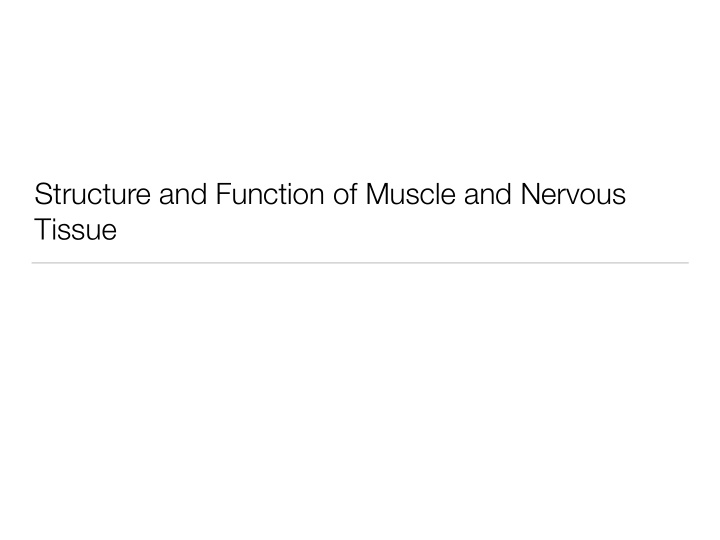



Structure and Function of Muscle and Nervous Tissue
What we’ll talk about… • Structure and functional features of muscle tissues • Structure of neuromuscular junction • Structure and organization of the spinal cord • Structure of peripheral nerves
Skeletal Muscle
Skeletal muscle consists of bundles of cells wrapped in connectives tissue layers. Epimysium Perimysium Endomysium
H&E stain reveals striated pattern and connective tissue layers. Cross Section Longitudinal Section Perimysium Nucleus Muscle Cell Endomysium
Each muscle cell is enveloped by endomysium and groups are wrapped by perimysium. Endomysium Capillary Perimysium Muscle cell Nucleus
Electron micrographs reveal the structural components of the sarcomere. T-tubule d n a b - H Z-disc Z-disc M-line Sarcoplasmic Reticulum n i t c A n i t c A n i s o y M d n a b - I d n a b - A
Skeletal muscle contains cells with different mechanical and biochemical properties. Slow-twitch Fast-twitch
Neuromuscular Junction
Motor neurons innervate skeletal muscle cells at neuromuscular junctions. Motor neuron axon Neuromuscular junction Skeletal muscle cell
Motor neurons form synapses on muscle cells at the neuromuscular junction. Muscle Cell Neuromuscular Junction Motor Neuron Axon
The neuromuscular junction contains a synapse between the axon terminus and skeletal muscle cell. Synaptic Vesicle Axon Terminus Basal Lamina Acetylcholine Receptors Muscle Cell Voltage-gated Na + Channels Sarcomere
Cardiac Muscle
Cardiac muscle consists of smaller, interconnected cells called cardiomyocytes.
Cardiomyocytes appear striated and have a central nucleus and connect at intercalated discs. Nucleus Intercalated Disc Capillary
Cardiomyocytes contain sarcomeres, numerous mitochondria and connect at intercalated discs. I-band Z-disc A-band Intercalated Disc Mitochondria Mitochondria
Intercalated discs contain adhering junctions and gap junctions. Intercalated Disc Sarcomere Adhering Junction Gap Junction Intercalated Disc Cardiomyoctye 1 Cardiomyoctye 2
Smooth Muscle
Smooth muscle contains spindle shaped cells.
Smooth muscle controls diameter of tubes such as blood vessels and bronchioles. Smooth Muscle Smooth Muscle
Smooth muscle cells are spindle-shaped with a single, elongated nucleus. Nucleus Cytoplasm
Some organs have layers of smooth muscle oriented in different directions. C o n t r a c t i o n Layer 1 Nucleus Layer 2
Dense bodies in smooth muscle cells function as Z-discs to mediate contraction. Nucleus Dense Bodies Cytoplasm
Adhering junctions connect adjacent smooth muscle cells. Smooth muscle cell 1 Adhering junction Smooth muscle cell 2 Smooth muscle cell 3
Smooth muscle cells can be individually innervated or work in groups via gap junctions. Multiunit Unitary
Gap junctions allows ions and current to pass between smooth muscle cells. Smooth muscle cell 1 Gap Junction Gap Junction Smooth muscle cell 2
Nervous Tissue
Spinal Cord
The cell bodies of motor neurons are found in the ventral horn. Dorsal Dorsal Horn White Matter Ventral Horn Grey Matter Dorsal Root Ventral Root Ventral
The dorsal root contains the cell bodies of sensory neurons. Sensory Neuron To Spinal Cord To Periphery
Motor neurons are multiple polar neurons that are found in the ventral horn. Dendrite Motor Neuron Support Cell
Nissl stain labels nucleic acids and highlights the rough endoplasmic reticulum in motor neurons. Dendrite Nissl Bodies Motor Neuron Axon Hillock
Peripheral nerves contain three layers of connective tissue. Epineurium Perineurium Endoneurium Arteries and Veins Fascicle Myelin Axon
Peripheral nerves with myelinated axons contain an unstained region around the axon. Epineurium Perineurium Axon Myelin Endoneurium
Electron micrograph reveals a myelinated axon and endoneurium with collagen. Schwann Cell Myelin Sheath Axon Endoneurium
Nerves with unmyelinated axons contain the same connective tissue layers. Schwann Cell Nucleus Epineurium Perineurium
Electron micrograph reveals unmyelinated axons and collagen in the endoneurium. Endoneurium Axon Schwann Cell Axon
Peripheral nerves appear wave-like in longitudinal sections. Schwann Cell Nucleus Epineurium
Ganglia are collections of neurons that relay signals from the CNS to the local tissue. Neuron Connective Tissue Satellite Cell
Recommend
More recommend